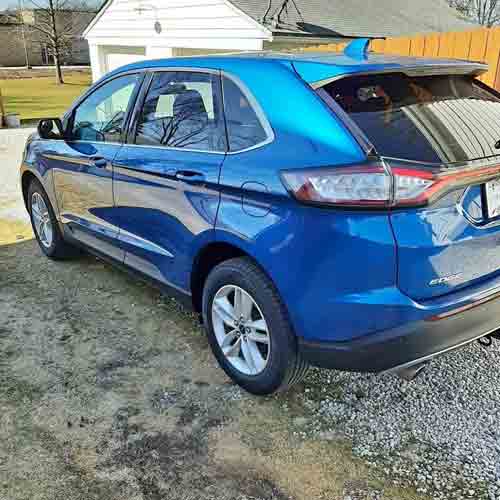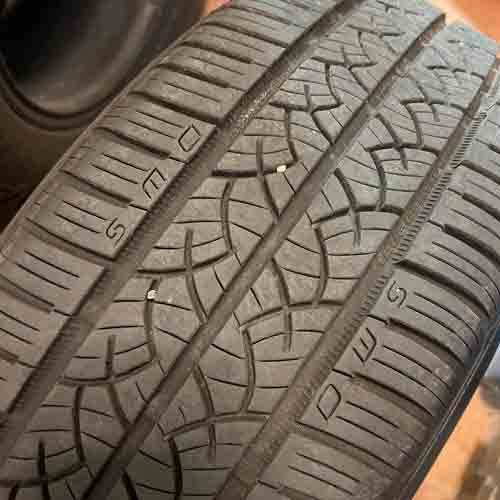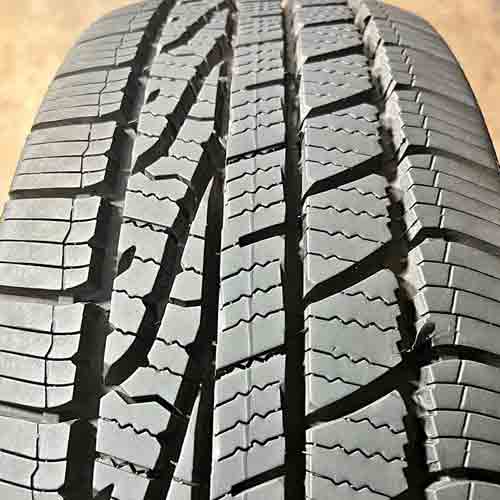Continental TrueContact Tour, designed for extended tread life and fuel efficiency, takes on Goodyear Assurance WeatherReady, a tire built for challenging conditions. This face-off is all about reliability and all-weather performance.

Being a tire engineer, my testing shows that the Goodyear Assurance WeatherReady excels in wet and winter traction and provides smoother bump absorption. Meanwhile, the Continental TrueContact Tour stands out in steering feedback, fuel efficiency, and noise reduction. So overall, both boys have their distinct advantages.
Diverse Sizing and Specs
The Continental TrueContact Tour comes with sizes having following specs.
- Rim sizes: 15 to 19 inches.
- Speed ratings: T, H and V.
- Load ratings: SL and XL.
- Tread depth: 11/32″ on all.
- Weight range: 16 to 32 lbs.
- Winter ratings: Only M+S.
- Treadwear warranty: 80k for T and H rated sizes or 70k mile for V rated ones.
- UTQG rating: 800 AA.
On the other side, the Goodyear Assurance WeatherReady has sizes with following specs.
- Rim sizes: 15 to 20 inches.
- Speed ratings: T, H and V.
- Load ratings: SL and XL.
- Tread depth: Either 10/32″ or 11/32″.
- Weight range: 19 to 37 lbs.
- Winter ratings: Yes both M+S/3pmsf available.
- Tread warranty: 60k miles.
- UTQG: 700 A A.
Outer Construction
Let’s start off with Continental.

So the TrueContact Tour tire comes with a symmetrical design comprised of four distinct ribs.
And of course, here the central 2 ribs are the main highlighting feature.
These ribs are characterized by X-shaped grooves, which basically interconnect all the longitudinal grooves with each other.
Moreover, they also join up with the tire’s curved linear siping.
Moving towards the shoulders, these ribs are very different form the central ones, as they only feature linear siping.
Moreover, they also have some distinctive features, such as snow vices (referring to their inner saw-toothed edges), and DWS markings.
Internally, the tire comes with a single ply polyester casing, with 2 steel belts, and two ply polyamide cap plies.
Moving towards the Goodyear Assurance WeatherReady. This tire comes with an asymmetric tread design.

At its core are three unique ribs form four circumferential channels.
The central most rib is the narrowest of all, and is characterized by wave-like siping and in-groove notches.
The adjacent ribs, although also carry similar siping pattern, they are more voided up with their pronounced jagged and sharp features.
Shoulder lugs are almost similar on both sides, though on one, they make more aggressive grooves, with their saw toothed edges, while the other is smoother.
Internally, this tire comes with 2 ply polyester casing with similar twin steel belts (though a little wider, relatively), and a single cap ply of polyamide reinforcement.
Highway Performance
When evaluating a tire’s efficacy on dry surfaces, two primary factors come into focus:
- The overall traction.
- And the overall steering response of the tire.
Let’s check them out one by one.
Overall Traction
The efficiency of tire traction is largely influenced by two critical components: dry or directional grip (which relates to straight-line traction) and lateral traction.
Now, here the Continental distinguishes itself with two prominent ribs that feature unique X-shaped, curved in-groove notches.
Interestingly, while there seems to be a separation due to these grooves, the ribs are underlaid by a continuous rubber layer. This design ensures stability, effective braking, and a commendable on-center feel.
However, when compared against its competitor here, it could benefit from a more streamlined center section.
That’s why on average, the Goodyear outperforms by offering a braking distance that’s two feet shorter, primarily due to its continuous central (most) rib.
This traction advantage is further amplified by the tire’s asymmetric adjacent ribs, which have a higher density of biters. And needless to say, those add to the overall grip, further.
Moving towards the lateral traction, (which gets measured by lateral g froces), we have the same story.
Though both tires provide comparable rubber-to-road contact via the shoulders, the Assurance WeatherReady’s increased number of biters ensures a more effective grip.
But the interesting thing here is that, the Goodyear tire still lacks when it comes to overall handling, as seen by its slower handling times on laps.
The reason? Well, put simply, it steering responsiveness tends to be more sluggish in comparison.
Steering Feedback
Now when it comes to steering feedback, the Continental TrueContact Tour is one of the best ones in its all season category.
This tire effectively communicates its (traction) boundaries, especially as it enters and exits corners. Furthermore, it also offers an exceptional balance of understeer and oversteer, during mid-cornering.
On the other hand, the Assurance WeatherReady falls short here, primarily due to its softer compound and increased weight.
Basically as the tire turns, its lugs getting more weight pressure on them, are more susceptible to bending, and this subsequently requires time for its tread to regain its original shape.
And so, this characteristic negatively impacts its overall dry lap testing performance.
Tread Wear
Tread life is influenced by factors such as the tire’s weight, composition, and tread depth. In this context, the Continental TrueContact Tour is taking the lead among the two.
The tire comes with a distinct rubber composition that offers increased resistance to high temperatures, and has features which ensures that it retains structural integrity even after prolonged use.
Both these features combined with its sturdy foundational supports for its lug allow this tire to last longer.
Whereas the Goodyear Assurance WeatherReady with its heftier construction and softer rubber compound pose challenges.
I mean, sure its rubber has its benefits, when it comes to winter traction, it comes with a trade-off—shortened tread life.
Wet Performance
Overall wet performance is two parts, where one is the tire’s ability to maintain grip on wet surfaces and, the other is its resistance to hydroplaning.
Let us explore both dimensions.
Wet Traction
In wet conditions, a tire’s performance is primarily determined by its ability to efficiently clear water from its tread, a task heavily reliant on the design and function of the tire’s sipes and grooves.
While grooves clear off majority of water, sipes come in later. These slits on the tread create negative pressure zones that pull in water particles, thus improving wet traction.
And since they have to contract/expand to create ample suction, the overall efficacy of sipes is also dependent on their flexibility too.
Now considering this, it can be explained why the Goodyear Assurance WeatherReady takes the upper hand here.
This superiority can be attributed to the tire’s denser siping, and their ability to maintain flexibility, even during aggressive cornering, courtesy of their intricate design and the tire’s overall softer tread.
On the other side, the Continental TrueContact Tour trails slightly behind as it only features linear sipes (aren’t as effective), and the tire comes with a stiffer rubber composition, which means it doesn’t achieve the desired sipe flexibility, limiting its suction capabilities in comparison.
Hydroplaning
The resistance to hydroplaning, a critical attribute of a tire, often goes underappreciated, despite its significance in maintaining overall wet traction.
Basically this aspect tells about the tire’s ability to channel water out via its primary grooves, and is measured by float speeds (which tells how fast a tire can move over watery surface, without losing traction).
Now, here both tires do great, as seen by their similar curved and straight aqua float speeds.
They both have great inter-connectivity of their grooves, (in both longitudinal and lateral directions), so water is easily thrown out in all directions.
Ride Comfort
Touring tires are primarily designed to ensure a smooth and comfortable drive, where they offer good enough bumps and noise dampening abilities.
Let’s discuss both these factors one by one.
On Road Vibrations
When it comes to dampening road vibrations, there are two things to consider.
- The tire’s role to act as a secondary suspension system.
- The overall steadiness and stability of the ride.
And since the tire’s construction plays the main role here, it makes sense why the Continental TrueContact Tour, built with stiffer rubber and fortified with a spirally wound nylon cap ply, is lacking here.
Whereas the Goodyear Assurance WeatherReady, equipped with thermally adaptive and 3PMSF certified rubber, offers superior bump absorption.
Noise Dampening Ability
A tire’s noise production primarily stems from the collision of air particles with the tread walls.
That’s why it makes sense why with more voided up structure, the Goodyear Assurance WeatherReady is lacking here.
In contrast, the Continental TrueContact is a much quieter option, where it only generates a minor hum, and even that blends out with the ambient background white noise.
This reduced noise is mainly credited to the tire’s superior variable pitch pattern.
Such design offers varying interaction points on lugs, where air particles striking, create a spectrum of sound frequencies, which (try to) cancel out each other, lowering noise.
Winter Performance
When evaluating winter performance, both tires showcase unique attributes in their handling of snow and ice.
Starting with the Continental TrueContact Tour, this tire offers good enough snow performance, thanks to its two central ribs loaded with numerous biting edges.
I mean, it’s curved X shaped central grooves and siping there, interlocking with each other, provide superb snow to snow contact, which translates into appreciable grip.
However, these features still don’t quite match up to the WeatherReady’s asymmetric tread pattern, which are better engineered to capture more snow particles.
And its significant because snow adheres better to itself than to rubber.
Basically the tire features a multitude of traction-enhancing elements like zig-zag and chamfered edges, complemented by needle-like grooves for superior ice traction.
Moreover, its tread is also crafted with a thermally adaptive rubber, ensuring its traction elements remain flexible even in freezing temperatures, unlike the Continental’s biters.
That’s why it also makes sense why unlike the TrueContact Tour is the only one here, lacking with the 3-peak mountain snowflake (3PMSF) rating.
Fuel Efficiency
Fuel efficiency in tires is intrinsically linked to the friction produced by the tread against the road. So here, understandably, factors such as a tire’s weight, composition, and design play a pivotal role.
And considering these variables/factors, the Continental TrueContact Tour emerges on top.
And it makes sense too, as the tire tire incorporates the EcoPlus Technology, specifically crafted to curtail CO2 emissions and diminish rolling resistance.
And it features a lighter weight, thanks to its single ply construction, which basically puts less weight pressure on the lugs, as they rub against the road, further lowering that resistance.
Whereas the Assurance WeatherReady’s bulkier construction and softer compound don’t fare here so well, comparatively.
You see both these factors on Goodyear, makes its lugs more prone to bending. And this deformation translates to energy being converted into heat, (a wastage that could have otherwise propelled the tire’s movement).
Take Home Points
So overall, each tire offers distinct advantages, so the ideal selection would vary based on your requirements.
The Continental TrueContact Tour shines in areas like steering feedback, fuel efficiency, and noise reduction.
In contrast, the Goodyear Assurance WeatherReady demonstrates superior capabilities in traction on both wet and winter terrains and offers smoother bump absorption.